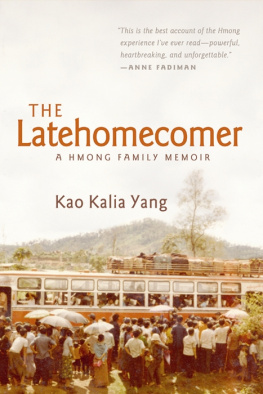
Table of Contents
LIBRARY OF CONGRESS CATALOGUING-IN-PUBLICATION DATA
Morrison, Gayle L.
Sky is falling : an oral history of the CIAs evacuation of the Hmong from Laos / by Gayle L. Morrison
p. cm.
Includes index.
ISBN-13: 978-0-7864-3753-5
1. Vietnamese Conflict, 19611975Laos. 2. Vietnamese Conflict, 19611975Personal narratives. 3. Hmong (Southeast Asian people) 4. Political refugeesUnited States. 5. United States. Central Intelligence Agency. I. Title.
DS558.6.L3M67 2008
959.704'34dc21 98-34811
1999 Gayle L. Morrison. All rights reserved
No part of this book may be reproduced or transmitted in any form or by any means, electronic or mechanical, including photocopying or recording, or by any information storage and retrieval system, without permission in writing from the publisher.
Cover design by Gayle L. Morrison
McFarland & Company, Inc., Publishers
Box 611, Jefferson, North Carolina 28640
www.mcfarlandpub.com
Jerry was strong and helpful and really loved and understood Hmong people. He stayed with the Hmong for many, many, many years, and he had the best relationship with us.
Jerry died in Bangkok, but he was buried in Montana. At his funeral his mother said: Well, Vang Pao, this is your son, and you can do whatever you want. You can do his funeral by the Hmong custom. So thats what we did. With drums [nruas] and qeej, we did the Hmong way for Jerry.
former Sky employee
Funeral wreath with picture of Jerry Daniels, May 10, 1982, Missoula, Montana. Wreath inscription: All your Hmong Associates, Field Liaison Officers, The Forward Air Guide. (Carol Leviton-Wetterhahn collection)
In Memory of Jerry Hog Daniels
June 11, 1941April 28, 1982
ACKNOWLEDGMENTS
This book could not have been written without the help of many individuals. I want to extend special thanks to each and every one of the following.
First, thanks are due General Vang Pao, the person who made me aware of the evacuation story within a much larger historical perspective. Throughout the project he was generous with his responses to any questions I had and was congenial about my interviews with many of his family members.
I am grateful to my former employer, Lao Family Community, Inc., as well as to my current employer, Lao-Hmong Security Agency, Inc., who allowed me to take extensive periods of time off from work to continue research for this book. I owe much to both employers for their flexibility, generosity, and encouragement.
Thanks go to my host-friends who graciously took me into their homes on my many research and interviewing trips: Nai V. and Pheng Moua (Fresno, California), whom I have had the pleasure of knowing for 20 years and who let me stay with them as family, sometimes for weeks on end; Elizabeth Kirton, who provided good friendship and wonderful hospitality in Fresno, in Phanat Nikhom, Thailand, and in Vientiane, Laos; Laura Leonelli (Sacramento, California), who introduced me to many members of the Sacramento Hmong community as well as played the consummate hostess to a road-weary friend; Ava Dale and Charles Johnson (St. Paul, Minnesota), who graciously allowed me to descend upon them annually to continue my Twin Cities interviews; also hosts Suzy Moser and Chris Berrisford (Hong Kong), Xia Y. and Lia Vang (Dallas, Texas), Scott Takushi and family (Minneapolis, Minnesota), Bee and Koua Moua (St. Paul), Beui M. and Va Xiong (Southern Pines, North Carolina), Ms. Lucie Yang and family (Mt. Gilead, North Carolina), Mr. and Mrs. Xao Lee and family (Connelly Springs, North Carolina), and Mr. and Mrs. Lo Ma (Morganton, North Carolina).
Thanks go also to the many translators who gave freely of their time and energy: in southern CaliforniaChong Vang, Yang Toua Chiachue, Mrs. Maikou V. Saykao, Seng Kue, Blong Moua, Mrs. Mayjoua (Joyce) L. Vang, Mrs. Shoana V. Ly, and Ms. Paj Nhiag Vang Nengchu; in FresnoPheng Moua, Ms. Misty Moua, Paul T. Moua, and four translators from the Hmong Senior Citizen Program, Ms. Choua Yang, Mrs. Tsor Yang, Mrs. Choua Lee, and Mrs. Sherry Ly; in SacramentoChee Vang, Rocky Vang, and Mrs. Fahm Seng; in MinnesotaBlia Thor, Yao Lor, and Bee Yang; in GeorgiaMiss Paja Xiong; and in North CarolinaTeng Vang.
Academic and professional encouragement was provided by Bruce T. Downing, Timothy N. Castle, Ava Dale and Charles Johnson,
Jane Hamilton-Merritt, William M. Leary, Larry D. Sall, and Sally Peterson. Anne Frank and Nancy Caudill are two librarians who used their extensive expertise to locate archival reference materials for me.
I would like to thank the agencies that let me borrow an office in which to conduct interviews from time to time: Sacramento Lao Family Community, Inc., Lao Family Community of Minnesota, Inc., Lao Family Community of Fresno, Inc., Lao Ethnic Association, Inc. (Fresno), Hmong Council, Inc. (Fresno), and Hmong Mutual Assistance Association, Inc. (Minneapolis).
Thanks are due the friends and colleagues who provided a variety of functions and services out of their enthusiasm for this project and the kindness of their hearts. First and foremost, I thank my good friend Nhia Vang, who provided hundreds of hours of technical support over the course of many years to keep my computer running. Roger Warner offered a collegial spirit and a remarkable Rolodex and paved the way for me to meet some of the extraordinary old Lao hands who still live in Bangkok, Thailand. Tim Pfaff and the Chippewa Valley Museum (Eau Claire, Wisconsin) included this research project as part of a Hmong History Series. A special thank-you goes to my friends in the Air America Association, especially Brian Johnson, Jane E. Mullins, Jack Knotts, and Dr. Larry Sall. It is an honor and a pleasure to feel welcomed by this friendly group of seasoned pilots and support personnel who know Laos in a very unique way.
Thanks are also due Carolyn Bowlen, Jonathan Brostrum, John Chang, Pichai Chuensuksawadi (Bangkok Post), George Dalley, Esther Dendel, Gina Froelich, Eileen Granosky, Sally Hoff, Harriet Hope, Christine Kopitzke, Judy Lewis, Sheryl Markham, John Melton, Peter Morrison, George Moua, Elaine Rubenstein, Lupe Salazar (Los Angeles Times), Jim Schill, Anourack Soukhaseum, Cheu Thao, MacAlan Thompson, Dr. Lue Vang, Terrence Wang, Carol Leviton-Wetterhahn, Ralph Wetterhahn, and Xang Yang.
A number of people have been helpful to me in my ongoing search for pictures of the Long Cheng valley and the evacuation. Finding and copying pictures was a formidable task that took years to complete. Many people merit thanks for their efforts, most especially G. R. Jenkin, who took numerous fine photos of the Long Cheng valley, and also Galen Beery, Bao V. and Mouasu Bliaya, George Dalley, J. R. Johnson, Jack Knotts, Ly Teng, Ly Tou Pao, Tou Geu Lyfoung, Susan Lindbergh Miller, Blong Moua, Nao Thao Moua, Nai V. and Pheng Moua, James E. Parker Jr., Allen Rich, Jim Schill, Steve Schofield, Scott Takushi, Cha Vang, Maykao L. and Chao Vang, Mao H. and Chu Vang, Mrs. May Song Vang, Mrs. Chia M. Vang, Nhia Vang, Roger Warner, Carol Leviton-Wetterhahn, Yang Chee, Chong Ge Yang, Jay Ge Yang, Mrs. Tong V. Yang, Yang Toua Chiachue, John Xiong Yang, and Ze Yang, all of whom let me make copies of their personal collections of Laos photos and slides. The
CAT
/Air America Archives at the University of Texas at Dallas was exceedingly helpful in my search for photos of northern Laos.
I offer a big hug of thanks for the ongoing support of my entire extended family, in particular my father, Lewis C. Pope, who has a love of airplanes and who slipped me extra gas money so that I could continue my research, and my mother, Letty Jo Pope, who played the vital role of being my mother and who never quit worrying over me and my travel adventures.
Next page
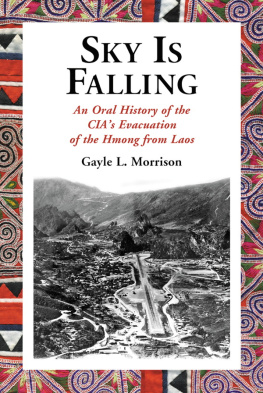
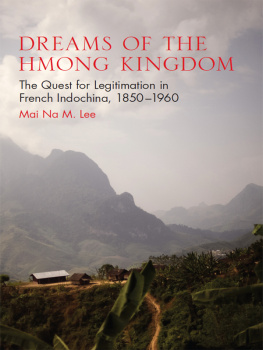

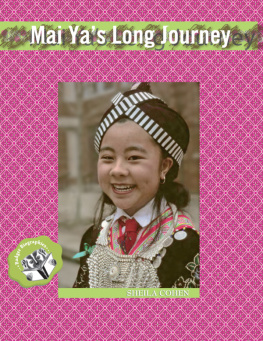
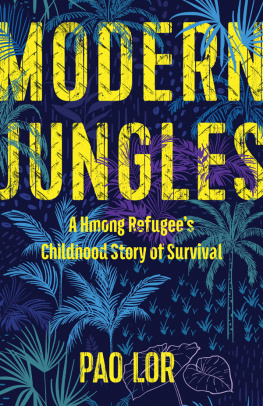
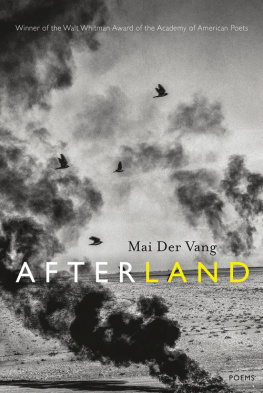

![Yang - The latehomecomer: [a Hmong family memoir]](/uploads/posts/book/165016/thumbs/yang-the-latehomecomer-a-hmong-family-memoir.jpg)

